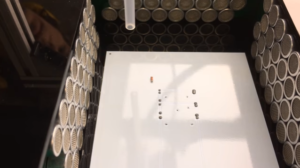 If you’ve ever had the feeling that everything you touch turns to, ah, the opposite of gold, a newly developed 3D printing technology emerging from Lithuania might just be the one for you. The Ultrasound Research Group at Neurotechnology has announced a new 3D printing method using ultrasonic manipulation technology that’s totally hands-off. It’s not just human hands either; the new method has totally non-contact tech behind it, allowing for the manipulation of parts and particles, down to the submillimeter range, without causing damage to sensitive components.
If you’ve ever had the feeling that everything you touch turns to, ah, the opposite of gold, a newly developed 3D printing technology emerging from Lithuania might just be the one for you. The Ultrasound Research Group at Neurotechnology has announced a new 3D printing method using ultrasonic manipulation technology that’s totally hands-off. It’s not just human hands either; the new method has totally non-contact tech behind it, allowing for the manipulation of parts and particles, down to the submillimeter range, without causing damage to sensitive components.
“Ultrasonic manipulation can handle a very large range of different materials, including metals, plastics and even liquids. Not only can it manipulate material particles, it can also handle components of various shapes. Other non-contact methods, like the ones based on magnetic or electrostatic forces, can’t offer such versatility,” explained research engineer Dr. Osvaldas Putkis, project lead for Neurotechnology’s Ultrasound Research Group.
- The ultrasonic array suspends a component
Neurotechnology is a Vilnius-based company, founded in 1990 under the name Neurotechnologija, that released its first technology — a fingerprint identification system — in 1991 and has been developing and updating new technologies since, having released more than 130 products and version upgrades throughout its history, including work with 3D modeling. The company’s Ultrasound Research Group began work in developing ultrasonic 3D printing products in 2014, and today announced its new technology, which according to the company is set to “enable 3D printing and assembly of almost any type of object using a wide range of different materials and components.”
If you’re thinking that it sounds like a good idea to bring sound into 3D printing, you (and Neurotechnology) are not alone; Fabrisonic incorporates sound waves into its patented metal 3D printing process, welding layers together via Ultrasonic Additive Manufacturing (UAM) in a hybrid subtractive/additive manufacturing process. Sound waves have additionally been incorporated into more artistic endeavors, as Dutch artists brought vibrations into 3D printed clay creations and 3D printing came into play with work in acoustic manipulation.
Because the work from the Ultrasound Research Group represents a new technological application, Neurotechnology has filed a patent on their system. Neurotechnology describes ultrasonic manipulation as a “non-contact material handling method which uses ultrasonic waves to trap and move small particles and components.”
The company has shared a video to demonstrate the hands-off capabilities allowed for via ultrasonic manipulation, as their prototype printer can assemble a simple printed circuit board (PCB):
Ultrasonic transducers are arranged in this demonstration in an array used to position electronic components in the creation of a PCB, utilizing a camera to detect accurate positioning. Continuing on with the hands-off theme, a laser solders the PCB components after their non-contact manipulation into placement.
Important components to the system as described include the ultrasonic array, camera, and soldering laser:
- Ultrasonic array
- Mounted camera
- Laser
Curious about what Neurotechnology is working on? We are, too, and we’ll be hearing directly from the company with additional details and insights into their new ultrasonic-based 3D printing technology soon.
We do know now that the company’s 3D printing apparatus and method of ultrasonic manipulation are patent pending, and that Neurotechnology is looking to collaborate with interested companies toward furthering the development of and applications for the new technology.
- The projected path of the electronic component
- Components getting into place for the PCB
- Non-contact laser soldering
3D printing and PCB manufacture are increasingly coming together, as advanced technologies benefit the creation of devices in electronics, including via 3D printed workstations for PCBs. The 3D printer we hear about most often in conjunction with PCBs is of course the DragonFly 2020 from Nano Dimension, which creates, not just assembles, PCBs — but they are by no means the only 3D printing player in the electronics space, as others are also looking to change things up and offer additional options in this growing application. As Neurotechnology notes that their method works with all kinds of materials, we can expect to see additional applications beyond PCB assembly, and look forward to sharing more details soon regarding the development and capabilities of their as-yet-unnamed 3D printing technology.
[All images: Neurotechnology via YouTube screenshot]
Subscribe to Our Email Newsletter
Stay up-to-date on all the latest news from the 3D printing industry and receive information and offers from third party vendors.
Print Services
Upload your 3D Models and get them printed quickly and efficiently.
You May Also Like
Authentise and Kform Tackle Defense Bottlenecks with Project DDNA — A Scalable Business Opportunity?
Authentise, a Philadelphia and UK-based software provider specializing in workflow management solutions for digital manufacturing technologies, has launched Project DDNA, a defense-oriented platform built off of its Threads and Flows...
Fortius Metals’ Jeph Ruppert on Why Wire-Based AM is Ready for Takeoff
Jeph Ruppert may have only been at Fortius Metals for a couple of months, but he knows the intricacies of additive manufacturing (AM) like someone who’s been steering the company...
3D Printed Drone Accelerator Firestorm Labs Continues Its Tear With $47M Series A
Firestorm Labs dominated the additive manufacturing (AM) industry’s attention in the first half of 2025, kicking off the year with its announcement of a $100 million Indefinite Delivery, Indefinite Quantity...
Croom Medical Signals Potential for 3D Print Diversification in Nuclear Fusion
As international interest in reshoring continues to mount, the additive manufacturing (AM) industry clearly has key advantages to offer suppliers scrambling to develop alternatives to traditional supply chains. One of...








































